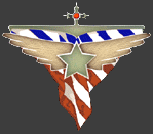Allied Units
Armoured Units
Allied Armour doctrine suffered from the effect of an old guard of Great War generals. Their views on armoured warfare were very much based on the pitched battles seen during this conflict but out of date in the face of the mobile warfare being waged by the Germans. It took a series of losses for this to become apparent, and with the entry of the US into the war came the industrial might needed to build a new mechanised army based on the principles of mobile armoured warfare the Germans had pioneered but were begining to abandon in favour of heavier tanks and more conventional strategies. By the end of the war the Allies had the most agile tanks with some of the most devastating weapons in the world. Although they suffer from their strategic situation - shipping tanks from the US allows for little creativity in force composition - America's huge industrial output combined with potent designs makes the Allies a highly effective force able to wage mobile warfare even better than the Germans themselves.
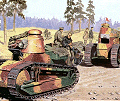 Renault
Renault FT 17
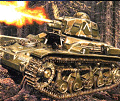 Renault
Renault R35
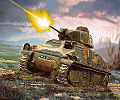 Somua
Somua S35
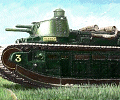 Char 2C
Char 2C FCM 2C
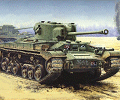 Vickers
Vickers Valentine
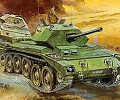 Crusader
Crusader A15
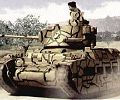 Matilda
Matilda Mk II
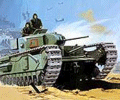 Churchill
Churchill Mk1
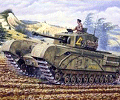 Churchill
Churchill Mk3
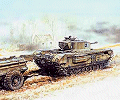 Churchill
Churchill Crocodile
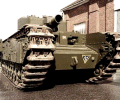 Churchill
Churchill AVRE
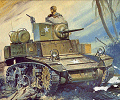 M3 Stuart
M3 Stuart Light Tank
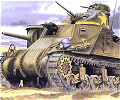 M3 Lee
M3 Lee Medium Tank
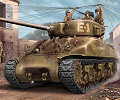 M4A1
M4A1 Sherman
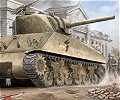 M4A3
M4A3 Sherman
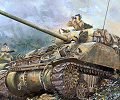 Sherman
Sherman Firefly
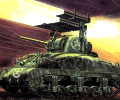 Sherman
Sherman Calliope
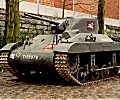 M22
M22 Locust
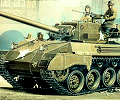 M18
M18 Hellcat
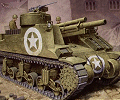 M7
M7 Priest
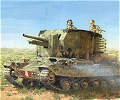 QF 25pdr
QF 25pdr Bishop
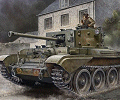 Cromwell
Cromwell A27
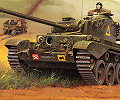 Comet
Comet A34
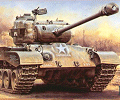 M26
M26 Pershing
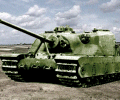 Tortoise
Tortoise A39
 Back
Back
Renault FT 17
Tech:
StartDelivered At:
Command CentreHealth:
230Armour:
Light-MediumFirepower:
9 (bullet)Rate of Fire:
(rapid fire)Range:
150Speed:
16The Renault FT 17 was one of the most successful tanks of the Great War. At the time, there was a big conflict between two schools of thought - a straight forward division between quantity over quality. The quantity lobby won by because of the inherent impracticality of equipping an entire army with very expensive and complicated tanks. For its day the FT 17 was ground breaking, the layout of a turret mounted weapon, engine at the rear and driver in the front became the standard pattern for all future tanks. The stunning success of this tank led to its adoption across many countries. The French army has a huge stockpile of these tanks but they were designed to fight against weapons that no longer exist in a manner that is no longer relevant. Their low speed and pathetic armour makes them only really useful as a scouting/distraction force although since they are so slow they are basically useless in this role as well. Yet they are plentiful and easy to call up and so will be supplied to serve as cannon fodder. At least they cost nothing.
 Back
Back
Renault R35
Tech:
StartCost:
700Built Time:
34 secsBuilt At:
French FactoryHealth:
290Armour:
Light-MediumFirepower:
85 (light penetration)Rate of Fire:
4 secsRange:
312Speed:
14The French are aware that the Renault FT-17 is obsolete but how best to improve on the design is not exactly clear with conflicting schools of thought. The Renault R-35 is basically a straight forward upgrade based on the same core philosophy. Designed to support infantry assaulting fixed positions in a pitched battle, the R35 is a reasonably solid design. It has very strong rounded armour and a powerful weapon. However its role as an infantry support tanks is basically obsolete. It suffers from even lower speed than the FT 17 which makes it hard to use in mobile warfare. They are best used in reserve and sent to reinforce defenses that come under attack. If it is used offensivly then it is likely to be out maneuvered. In limited operations its strong armour should protect, but in sweeping movements it will become isolated could be destroyed in counter-attacks by combined arms forces.
 Back
Back
Somua S35
Tech:
StartCost:
1500Built Time:
55 secsBuilt At:
French FactoryHealth:
286Armour:
MediumFirepower:
93 (light penetration)Rate of Fire:
8 secsRange:
360Speed:
28While the Somua may seem more modern and is certainly more useful than its fellow French tanks, it would be wrong to see it as the product of particularly inspired thinking by the designers. Rather it still forms a part of the overall strategy of fixed battles. The Somua is designed to fill the role of armoured cavalry, exploiting weaknesses in the enemy's lines and pushing into its rear areas to assist the troops mounting a frontal assault. By accident it turns out to be highly suitable for fighting in the type of armoured maneuver warfare the Germans are using to such great effect, but a very high cost ultimatly undermines its numerous advantages. Such expensive armour needs to operate with infantry and the slow infantry tanks for mutual protection while a small crew and cramped conditions make it inflexible and vulnerable to envelopment. Being forced to fight mostly at walking speed leaves the Somua unable to exploit the potential of its high speed, powerful gun and thick armour.
 Back
Back
Char 2C / FCM 2C
Tech:
StartCost:
3000Built Time:
60 secsBuilt At:
French FactoryHealth:
243Armour:
HeavyFirepower:
128 (high explosive)Rate of Fire:
8 secsRange:
450Speed:
7The Char 2C was the design rivaling the FT 17 towards the end of the Great War. Where the FT 17 emphasised low cost and an efficient layout the Char 2C was a grand tank designed to be immune to enemy fire. Very few were built but since the end of the war they have been very important for propaganda reasons. As such they have been upgraded to keep them up to date in terms of armour and weaponry. The huge 75mm high explosive cannon is more than capable of blasting enemy tanks to pieces while its huge armour is able to repel pretty much any type of enemy anti tank round. The tank is very much designed to support an infantry assault and so it does not move much faster than walking speed, however if it is in the right place at the right time its impact is devastating. At the very least these tanks will serve well as bullet sinks since the enemy is sure to focus all their firepower onto such an intimidating beast leaving smaller units to operate unhindered.
 Back
Back
Vickers Valentine
Tech:
Level 1Cost:
1280Built Time:
17 secsBuilt At:
British Light FactoryHealth:
386Armour:
MediumFirepower:
165 (light pentration)Rate of Fire:
5 secsRange:
406Speed:
15The Valentine tank is a response to the sudden need to equip the British Army with modern tanks. It features the 2pdr anti tank gun and thick armour. It is reasonably cheap given it can trump most contemporary enemy tanks but rushed production and an under powered engine leave it with a dubious top speed. Like the French tanks, it will not be able to perform any sweeping advances but should hold the line.
 Back
Back
Crusader A15
Tech:
Level 3Cost:
1280Built Time:
34 secsBuilt At:
British Light FactoryHealth:
337Armour:
MediumFirepower:
165 (light pentration)Rate of Fire:
5 secsRange:
406Speed:
31The Crusader is a cruser tank. It is much lighter than other British tanks but still has reasonable protection. The lighter armour allows for a much higher top speed and the Crusader is capable of rapid assaults. It is let down by its puny 2pdr gun that is clearly obsolete. However it can keep up with the American tanks arriving from the US and so is still a useful tank.
 Back
Back
Matilda Mk II
Tech:
Level 1Cost:
1600Built Time:
60 secsBuilt At:
British Heavy FactoryHealth:
469Armour:
HeavyFirepower:
165 (light pentration)Rate of Fire:
5 secsRange:
406Speed:
13The Matilda tank also sports the 2pdr anti tank gun but is much more heavily armoured than the Valentine. The most striking difference is the greatly increased time for production, but the payoff is in far greater protection for only a marginal increase in cost. For a cash concious commander the Matilda is a good option offering far better value for money, but the Valentine is ready sooner. Ultimatly the strategic situation will dictate which factor is more important.
 Back
Back
Churchill Mk1
Tech:
Level 2Cost:
1100Built Time:
60 secsBuilt At:
British Heavy FactoryHealth:
663Armour:
HeavyFirepower:
165 (light pentration)Rate of Fire:
5 secsRange:
406Speed:
17The Churchill is named for the new British prime minister. His fighting talk and desire for descisive action certainly are not embodied in the flawed Churchill tank. While it is an improvement over the Matilda, the Churchill is still deeply troubled. Poor mechanical qualities mean it has a low top speed and a complex design means that the build time is still very long. Its 2pdr armament is exactly the same as what is on the other tanks, but it is rapidly becomming obsolete. It is an improvement over what has come before, but only just. In its favour the Churchill is at least very well armoured and very solid. Destroying one is beyond the capabilities of most contemporary tanks and so it can absorb damage and lure enemy units into range of artillery or other defences.
 Back
Back
Churchill Mk3
Tech:
Level 3Cost:
1100Built Time:
60 secsBuilt At:
British Heavy FactoryHealth:
663Armour:
HeavyFirepower:
213 (light pentration)Firepower Upgraded:
388 (medium pentration)Rate of Fire:
5 secsRange:
406Speed:
17The Mk 3 addresses one of the most significant flaws with the Mk 1,
the under powered main gun. The 2pdr has been replaced with the 6pdr
which is much more powerful and able to deal more effectivly with
the heavier armour now seen on enemy tanks. Sadly the other weaknesses
remain with a poor top speed and long build time making the Churchills
unsuitable for offensive operations where they could be lost.
The Churchill can be upgraded later in the war to fire deadly APDS rounds, greatly
improving its ability to deal with heavier enemy tanks.
 Back
Back
Churchill Crocodile
Tech:
Level 6Cost:
1300Built Time:
60 secsBuilt At:
British Heavy FactoryHealth:
663Armour:
HeavyFirepower:
213 (light pentration)Rate of Fire:
5 secsRange:
406Speed:
17The Crodocile is an engineering tank. Basically a standard Mk3 with a flame-thrower mounted inside it. The Crocodile is a fearsome weapon for urban warfare, able to clear out enemy garrisons while being protected by the Churchill's thick armour.
 Back
Back
Churchill AVRE
Tech:
Level 6Cost:
1700Built Time:
60 secsBuilt At:
British Heavy FactoryHealth:
663Armour:
HeavyFirepower:
1600 (heavy explosive)Rate of Fire:
18.5 secsRange:
250Speed:
17The Armoured Vehicle, Royal Engineers (AVRE) is designed as a demolitions tank. The main gun is totally replaced by a 290mm spigot mortar hurling dustbin sized projectiles at the enemy. The short range belies the terrible destructive power of the mortar - it is able to shatter enemy tanks and fortifications, totally slaughtering garrisoned troops and stunning the crews of any tanks lucky enough to survive the explosion. Its role is to break up enemy defenses and strong points and then allow more mobile vehicles to explot the breach.
 Back
Back
M3 Stuart Light Tank
Tech:
US Intervention, Level 3Cost:
750Delivered At:
Command CentreHealth:
246Armour:
Light-MediumFirepower:
140 (light penetration)Rate of Fire:
2.5 secsRange:
360Speed:
39The M3 Stuart is part of the first wave of US deliveries following Uncle Sam's intervention in the war. As a light tank, the Stuart is in many ways obsolete compared to enemy tanks, but it still has a number of fine qualities. The first is its speed. Together with the M3 Lee, the Stuart is able to give the Allied armoured division an offensive capability allowing them to take the offensive for the first time in the war. The arival of the US is a watershed moment and with tanks like the Stuart the Allies are finally able to take the initiatve and launch attacks. The Stuart's light fire power is compensated by a very fine turret allowing for a high rate of fire. While the light armour makes it unable to win against equal numbers, it is very well equipped for flanking attacks agaisnt enemy tanks that are already engaged with heavier units.
 Back
Back
M3 Lee Medium Tank
Tech:
US Intervention, Level 3Cost:
1300Delivered At:
Command CentreHealth:
263Armour:
MediumFirepower:
175 (light penetration)Rate of Fire:
5 secsRange:
360Speed:
23The M3 Lee forms the other half of early US tank forces. The chassis will go on to form the basis for the very successful Sherman, but the main turret was only large enough to carry an under-powered 37mm gun. However the Lee also packs a 75mm HE cannon in a coaxial sponson in the chassis allowing it to take on fixed defensive positions and garrisoned troops. As with the Stuart, the mobility of the Lee allows the Allies to finally sieze the initiative and that alone should not be underestimated.
 Back
Back
M4 Sherman A1
Tech:
US Intervention, Level 4Cost:
1200Delivered At:
Command CentreBuilt At:
Command CentreBuild Time:
60 secsHealth:
421Armour:
MediumFirepower:
195 (medium penetration)Rate of Fire:
3 secsRange:
450Speed:
35The Sherman is a significant refinement of the Lee chassis with the 75mm gun now
mounted in the turret where it belongs and upgraded to be able to fire anti-tank
rounds as well as high explosives. The Sherman is an fairly expensive tank built
to a high specification, but such quality manufacture gives it many valuable
qualities. Firstly the mechanical reliability and great suspension allows for a high
top speed, something sorely lacking in Allied tanks to this point. Secondly it has
an excellent turret which gives it the ability to keep up a very high rate of fire,
even on the move. Finally the armour is well balanced giving it the ability to
resist rounds even from the 75mm German guns.
It can be upgraded to use dreaded White Phosphorus rounds. These chemical weapons
create a hellish environment around the target vehicle incapactiating it and making
it an easy target for friendly anti-tank guns guns.
 Back
Back
M4 Sherman A3
Tech:
US Intervention, Level 6Cost:
1420Delivered At:
Command CentreHealth:
481Armour:
MediumFirepower:
273 (medium penetration)Rate of Fire:
3 secsRange:
540Speed:
35The thicker armour of the German tanks means the US had to upgrade its Shermans to
use a more powerful gun. The A3 mounts a 76mm anti tank gun that has much better
performance than the old 75mm. The increased range and fire power combined with the
impressive rate of fire helps to keep the Shermans deadly against improved enemy armour.
It can be upgraded to use dreaded White Phosphorus rounds. These chemical weapons
create a hellish environment around the target vehicle incapactiating it and making
it an easy target for friendly anti-tank guns guns.
 Back
Back
Sherman Firefly
Tech:
US Intervention, Level 5Cost:
1550Built At:
British Light FactoryBuild Time:
60 secsHealth:
427Armour:
MediumFirepower:
430 (heavy penetration)Firepower Upgraded:
615 (heavy penetration)Rate of Fire:
6 secsRange:
630Speed:
35The trend in German tank designs towards heavier armour was pre-empted by the British.
To counter the threat of heavier enemy armour such as the Tiger they designed the 17pdr
cannon which is more than a match for such designs. The Sherman was the perfect chassis
to carry this gun and this hybrid of American and British design was called the Firefly.
The combination of great performance a fantastic turret and the devastating firepower
of the 17pdr makes the Firefly one of the most deadly tanks in Allied service.
The Firefly is a prime candidate to recieve the enhanced APDS ammunition. These sabot rounds
make the 17 pdr cannon even more powerful, making the Firefly a "giant killer" able to destroy
even the heaviest enemy tanks at extreme range.
 Back
Back
Sherman Calliope
Tech:
US Intervention, Special 3Cost:
1300Delivered At:
Command CentreHealth:
421Armour:
MediumFirepower:
1500 (rocket) (30 shot volley)Rate of Fire:
3 minsRange:
1000Spread:
400Speed:
35Mobile artillery is essential for modern armoured warfare. While the Priests and Bishops do a respectable job in bombarding enemy positions, sometimes the enemy are not obliging enough to stay in the same place while they are blasted appart. When launching an attack, a sustained artillery barrage can totally ruin the element of supprise. In these situations the Calliope comes into its own. The rocket barrage it can unleash devastates the target zone in a short space of time. Since the rockets are mounted on a standard Sherman, it can then attack with the rest of its fellow tanks and press home the advantage. The innacuracy of the rockets is a significant downside but this can be overcome by using several Calliopes together in a combined barrage.
 Back
Back
M22 Locust
Tech:
Air Level 3Cost:
27000 per drop - 30 Commandos & 3 Locust Tanks, includes 17500 rebate if DC-3s and Lancasters surviveBuilt At:
Air TowerRecharge Time:
3 mins 42 sec (per drop)Health:
246Armour:
Light-MediumFirepower:
140 (light penetration)Rate of Fire:
2.5 secsRange:
360Speed:
35The M22 Locust was originally a US tank project aiming to create an airborne tank. The problem was that they lacked a way to deliver the tank safely from the air to the ground. In this respect the British had the perfect solution in the Hamilcar glider. They took over the project and developed the tank to work in tandem with their own airborne divisions. The principle of the airborne tank was popular in the '30s and all sides attempted to solve the problem of delivering the tank to the battlefield, but only the Allies cracked the problem and deployed them in actual assaults. In battle the presence of armour transforms airborne forces from a minor annoyance to a major problem. Often the enemy will massivly over-compensate for their presence allowing conventional forces to easily penetrate their now weakened defences and hopefully save the airborne forces before they are wiped out.
 Back
Back
M18 Hellcat
Tech:
US Intervention, Level 5Cost:
1440Delivered At:
Command CentreHealth:
142Armour:
Light-Medium (open topped - vulnerable to explosives, grenades etc.)Firepower:
273 (medium penetration)Rate of Fire:
3 secsFirepower Upgraded:
465 (medium penetration)Rate of Fire Upgraded:
4 secsRange:
540Speed:
49The M18 Hellcat is designed according to US tank destroyer doctrine. This calls for very
fast vehicles with very powerful guns and a high top speed at the expense of armour. The
idea is to hold these vehicles in reserve and then rush them to counter attacks by enemy
armour. In reality they were very successful when they had the initiative and could attack
the side or rear of enemy tanks but were totally unable to resist any kind of return fire.
They can out-range many Allied tanks and so are able to operate behind a screen of more
resistent tanks, preserving their awesome firepower from retributon.
It can be upgraded to use APCR rounds which greatly enhance its armour peircing capabilities
and make it able to continue in its role of tank-killer even in the face of heavier enemy tanks.
 Back
Back
M7 Priest
Tech:
US Intervention, Level 4Cost:
1150Delivered At:
Command CentreHealth:
206Armour:
Light-Medium (open topped - vulnerable to explosives, grenades etc.)Firepower:
445 (high explosive)Rate of Fire:
7 secsRange:
1100Spread:
125Speed:
29The M7 Priest mounts a 105mm howitzer onto an armoured chassis giving US artillery batteries the ability to keep pace with armoured formations. The support of these guns can be very instrumental in a battle. Their extreme range can be used to blast enemy troops at long range or lay down a suppressive smoke screen. US artillery doctrine calls for these units to be massed into batteries and so it would be a good idea to use several of these weapons at once to maximise the impact of their shells before the enemy moves.
 Back
Back
QF 25pdr Bishop
Tech:
Level 4Cost:
1200Built At:
British Light FactoryBuild Time:
30 secsHealth:
200Armour:
Light-Medium (open topped - vulnerable to explosives, grenades etc.)Firepower:
415 (high explosive)Rate of Fire:
7 secsRange:
1000Spread:
125Speed:
15The Bishop mounts a 87mm gun onto a Valentine chassis. It can be used to bolster the Priests. It moves more slowly but this is less important for support units like artillery since they don't need to be moved as rapidly or as often as tanks. Its 87mm gun is less powerful than the 105mm howitzer on the Priest but the Bishops can be built directly without having to order all the attendant baggage that the US sends along with their Priests.
 Back
Back
Cromwell A27
Tech:
Level 5Cost:
1500Built Time:
40 secsBuilt At:
British Light FactoryHealth:
415Armour:
MediumFirepower:
195 (medium pentration)Rate of Fire:
3 secsRange:
450Speed:
37The Cromwell is a British cruiser tank. These started out as cavalry tanks
designed to rush through gaps opened by infantry and heavy weapons. They
evolved into their current state through many abortive and disasterous designs
but with the Cromwell they have roughly reached a parity with the Shermans.
The advantage over the Sherman is simply that Cromwells are domestically
produced and so are slightly faster to build, albeit at a higher cost. The
need for more tanks takes priority at this stage of the war, the US provides
plenty of cash and so the extra cost is a small factor against the need for
more tanks.
It can be upgraded to use dreaded White Phosphorus rounds. These chemical
weapons create a hellish environment around the target vehicle incapactiating
it and making it an easy target for friendly anti-tank guns guns.
 Back
Back
Comet A34
Tech:
Level 6Cost:
1800Built Time:
60 secsBuilt At:
British Light FactoryHealth:
468Armour:
Medium-HeavyFirepower:
363 (heavy pentration)Firepower Upgraded:
533 (heavy pentration)Rate of Fire:
5 secsRange:
630Speed:
34The Comet is the moment where the cruiser tanks begin to edge ahead of the Shermans.
The heavier armour and addition of a short-barreled 17pdr requires the speed to be
restricted slightly to preserve the drive train. However the Comet is a fearsome tank.
They can absorb more damage than the Shermans and their fast speed and devastating
firepower makes them in many ways the perfect tank for maneuver warfare. Sadly there
is no way to produce them rapidly and in great numbers. The British industiral capacity
is simply not up to such a task. Even in limited numbers they are still a fearsome
tank and so long as they are not thrown away in useless battles it is possible to
build up a significant force.
The Firefly is a prime candidate to recieve the enhanced APDS ammunition. These sabot
rounds make the 17 pdr cannon even more powerful, making the Firefly a "giant killer"
able to destroy even the heaviest enemy tanks at extreme range.
 Back
Back
M26 Pershing
Tech:
US Intervention, Level 7Cost:
2420Delivered At:
Command CentreHealth:
653Armour:
HeavyFirepower:
355 (heavy pentration)Firepower Upgraded:
658 (heavy pentration)Rate of Fire:
4 secsRange:
720Speed:
29The M26 Pershing is a heavy tank and in many ways a response to the Tiger. The 90mm
is also an adapted anti-aircraft gun and the armour is comparable. The key difference
is the superior build quality of the American tank. With a better turret it can fire
faster than the Tiger, while better mechanical reliability makes it significantly
faster as well. It is the only fully fledged heavy tank availible to the Allies, but
the need to ship all US produced tanks across the Atlantic ocean means that the Allied
tank forces will continue to favour the smaller and more easily shippable Sherman.
The 90mm cannon is a prime candidate for APCR ammunition, as this long range weapon is
dramatically improved with this lethal ammunition varient and the thick armour of the
Pershing is more likely to survive engagments with enemy tanks.
 Back
Back
Tortoise A39
Tech:
Special Weapons Level 3Cost:
3900Built Time:
60 secsBuilt At:
British Heavy FactoryHealth:
1387Armour:
Super-HeavyFirepower:
550 (heavy pentration)Rate of Fire:
30 secsRange:
900Speed:
11Industrial Power:
-4The Tortoise is a huge Self Propelled Gun designed as a fail-safe. Should the Germans ever dig themselves into an impenetrable defensive line, these monsterous weapons could be brought out to blast their way though using their vast 32pdr cannons and immense bulk. They can crush mines since their puny explosions do little to hinder such a massive machine. The practicality of operating weapons like these makes them unsuitable for mobile warfare but the psycological impact is so profound that they can serve well as a bullet sink. Their dense armour makes them able to absorb a huge amount of punishment, and they can be used to draw enemy tank fire away from the mostly soft-skinned Allied armour. Even better, they can serve as bait to draw enemy tanks into ambushes from troops out on the flanks of their force.
